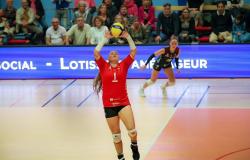– It accelerates intestinal transit, reducing exposure of the digestive mucosa to carcinogens from food.
Generally speaking, it is recommended to practice at least five days a week at least 30 minutes of moderate-intensity physical activity (comparable to brisk walking), or to practice 20 minutes of intense physical activity three days a week. high (comparable to jogging).
Practicing physical activity reduces the risk of recurrence by 24%. TRUE
In fact, practicing physical activity after diagnosis of breast cancer reduces the risk of recurrence by 24%, and the risk of death from cancer by 28% (1).
During treatment, physical activity contributes to a better quality of life for patients since it improves tolerance to treatments and reduces their possible side effects. It also reduces the fatigue induced by these treatments by 36% on average and improves sleep and body image (2).
“Adapted physical activity (APA) is a treatment that should not be stopped!” emphasizes Dr. François D’Halluin, breast surgeon at the Rennais du Sein Institution. APA will also help strengthen the heart muscle during and after chemotherapy and improve shoulder mobility after axillary dissection and mastectomy. »
A woman with breast cancer will not be able to have children. FAUX
Oncofertility is a discipline that attempts to provide long-term protection from the side effects of breast cancer treatments on the patient’s fertility. “Before, we wanted to save a woman; now, we want to save a woman by limiting long-term side effects,” explains Dr. Solène Duros, obstetrician-gynecologist at Rennes University Hospital. This is why an oncofertility consultation is offered to every woman under 40 years old.
Several techniques exist: freezing the oocytes with or without ovarian stimulation; freezing embryos; remove an ovary. The technique chosen is on a case-by-case basis.
Be careful however, an oncofertilty session cannot guarantee 100% of having a child either: “Oocyte freezing does not guarantee 100% pregnancy, it is not insurance; but it’s still a catch!
According to a recent study, 80% of women under 35 will have a spontaneous pregnancy after breast cancer and 73.7% between 35-39 years old,” continues the specialist.
Tobacco and alcohol have an impact on the development of breast cancer. TRUE
Tobacco consumption is associated with an increased risk of several cancers including breast cancer.
Concerning alcohol, the increase in risk of breast cancer is significant from an average consumption of one drink per day. Reference studies attribute 15% of breast cancers to regular alcohol consumption, even moderate (3).
You should seek medical advice if you notice an abnormality. TRUE
Any abnormality in the breast does not mean you have breast cancer! “There are many benign entities that can form a “lump” in the breast: cyst, fibroadenoma, calcifications,” indicates the Foundation for Medical Research.
However, whatever your age, a medical consultation is imperative in the event of the appearance of certain signs: change in the shape and/or size of the breast, discharge, redness or heat, appearance of a mass or a dimple, skin change, etc. Analyzes will be carried out.
Men cannot develop breast cancer. FAUX
Men can also be affected by this pathology, but this remains very rare: less than 1% of all breast cancers affect men (4).
In 15% of cases, this male breast cancer is linked to a genetic predisposition. But other risk factors come into play such as Klinefelter syndrome, exposure to radiation and more particularly in the thorax, cirrhosis of the liver. The vast majority of male cases of breast cancer are infiltrating ductal carcinomas, expressing hormone receptors, as in women, and are treated with the same therapeutic arsenal (5).
A decreasing mortality rate. TRUE
In 2023, in France, the number of new cases is estimated at 61,214, an increase of 0.3% per year since 2010 (6). According to a study published by the International Agency for Research on Cancer, France is the country most affected by breast cancer, with an incidence rate of 105.4 cases per 100,000 inhabitants in 2022. This is the most common cancer in women in France.
The number of deaths attributable to breast cancer is estimated at 12,600 in 2021. That is a decrease of 1.3% per year since 2011. Much progress has been observed in the treatment of breast cancer over the last 30 years. And the earlier breast cancer is detected, the easier it is to treat, and the higher the chances of recovery. Hence the importance of organized screening for women aged 50 to 74 in France.
If there are cases in the family, I would definitely have breast cancer. FAUX
5 to 10% of breast cancers are linked to a hereditary genetic abnormality. In the majority of cases, it is a mutation in the BRCA1 or BRCA2 gene.
Being a carrier of one of these mutations does not mean that you will necessarily have breast cancer, but the lifelong risk reaches 40 to 80%: this is what we call a genetic predisposition. For these women, an ontogenetic consultation allows specific treatment to be put in place (7).
Sources
(1) : Fondation ARC.
(2) : Fondation ARC.
(3) : INCa.
(4) : INCa.
(5): Foundation for Medical Research and INCa.
(6) : Cancer Panorama 2024 – INCa.






